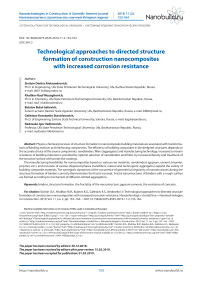Technological approaches to directed structure formation of construction nanocomposites with increased corrosion resistance
Автор: Sinitsin D.A., Khalikov R.M., Bulatov B.G., Galitskov K.S., Nedoseko I.V.
Журнал: Nanotechnologies in Construction: A Scientific Internet-Journal @nanobuild-en
Рубрика: System solutions for technological problems
Статья в выпуске: 2 Vol.11, 2019 года.
Бесплатный доступ
Physico-chemical processes of structure formation in nanocomposite building materials are associated with transformations of binding matrices and reinforcing components. The efficiency of building composites in the designed structures depends on the accurate choice of the source components: nanobinders, fillers (aggregates) and manufacturing technology. Increased corrosion resistance of building materials is provided by optimal selection of nanobinders and fillers, by increased density and treatment of the structure surface with protective coatings. The manufacturing feasibilities for nanocomposites based on various raw materials, nanobinders (gypsum, cement, bitumen, polymer, etc.), and inclusion of various dispersed phases (nanofillers, natural and technogenic aggregates) expand the variety of building composite materials. The synergistic dynamism of the occurrence of geometrical regularity of nanostructures during the structure formation of binders correctly demonstrates the fractal concept. Fractal nanostructures of binders with a rough surface are formed according to mechanism of diffusion-limited aggregation.
Binders, structure formation, the fractality of the microstructure, gypsum cements, the resistance of concrete
Короткий адрес: https://sciup.org/142227502
IDR: 142227502 | DOI: 10.15828/2075-8545-2019-11-2-153-164
Список литературы Technological approaches to directed structure formation of construction nanocomposites with increased corrosion resistance
- Figovsky O.L., Beilin D.A., Ponomarev A.N. Uspekhi primeneniya nanotekhnologiy v stroitel’nykh materialakh [Successful implementation of nanotechnologies in building materials.] Nanotehnologii v stroitel’stve = Nanotechnologies in Construction, 2012. Vol. 4, no. 3. P. 6–21. (In Russian).
- Bazhenov Y. M., Chernyshov E. M., Korotkikh D. N. Konstruirovaniye struktur sovremennykh betonov: opredelyayushchiye printsipy i tekhnologicheskiye platformy [Design of modern concrete structures: defining principles and technological platforms.] Construction Materials. 2014. No. 3. P. 6–14. (In Russian).
- Ostroukh A.V., Nedoseko I.V., Surkova N.E., Bulatov B.G. Automated control system for the milling unit of mineral powders plant. International Journal of Applied Engineering Research. 2016. V. 11, no. 4. P. 2625–2628.
- Vstovsky G.V., Kolmakov A.G., Bunin I.Zh. Vvedeniye v mul’tifraktal’nuyu parametrizatsiyu struktur materialov [Introduction to the multifractal parameterization of material structures.] Moscow, SIC “Regular and chaotic dynamics”, 2001. 116 p. (In Russian).
- Korenkova S.F., Sidorenko J.V. K voprosu o fraktal’noy razmernosti nanotekhnogennogo syr’ya [To the question about fractal dimension of nanotechnological stuff.] Nanotehnologii v stroitel’stve = Nanotechnologies in Construction, 2010. Vol. 2, no. 3. P. 26–32. (In Russian).
- Mashukov N.I., Khalikov R.M., Kharaev A.M. Stabilizatsiya i modifikatsiya molekulyarnykh struktur [Stabilization and modification of molecular structures]. Saarbrucken, Palmarium Academic Publishing, 2014. 210 p. (In Russian).
- Komokhov P. G. Zol’-gel’ kak kontseptsiya nanotekhnologii tsementnogo kompozita [Sol-gel as a concept of nanotechnology of cement composite]. Construction Materials. 2006. No 9. P. 89–90. (In Russian).
- Witten T.A., Sander L.M. Diffusion-limited aggregation. Physical Review. 1983. V. 27, no. 9. P. 5686–5697.
- Sinitsin D.A, Salova M.S., Sultanshina E D., Ryazanova V. A. Primeneniye betona povyshennoy prochnosti pri betonirovanii fundamentnoy plity pod vysotnyy zhiloy dom v g. Ufa [The use of high-strength concrete in concreting the foundation slab under the high-rise residential building in the city of Ufa]. Materials Conf. “Actual problems of technical, natural and humanitarian sciences”. Ufa. 2016. P. 123–125. (In Russian).
- Lesovik V.S., Chulkova I. S. Upravleniye strukturoobrazovaniyem stroitel’nykh kompozitov [Management of structure formation of building composites.] Omsk, SibADI, 2011. 420 p. (In Russian).
- Evelson L.I., Lukutsova N.P., Nikolaenko A.N. et al. Nekotoryye prakticheskiye aspekty fraktal’nogo modelirovaniya struktury nanokompozitsionnogo materiala [Some practical aspects of fractal modeling of the structure of nanocomposite materials]. Construction Materials. 2015. No 11. P. 24–27. (In Russian).
- Kudryavtsev P.G. Sostav i struktura poristykh termostoykikh neorganicheskikh kompozitsionnykh materialov [Composition and structure of porous heat-resistant inorganic composite materials.] Nanotehnologii v stroitel’stve = Nanotechnologies in Construction. 2018. Vol. 10, no. 4, pp. 75–100. DOI: dx.doi.org/10.15828/2075- 8545-2018-10-4-75-100. (In Russian).
- Mukhametshin V.V., Kadyrov R.R. Vliyaniye nanodobavok na mekhanicheskiye i vodoizoliruyushchiye svoystva sostavov na osnove tsementa [Influence of nanoadditives on mechanical and isolating properties of cement-based compositions]. Nanotehnologii v stroitel’stve = Nanotechnologies in Construction. 2017. Vol. 9, no. 6, pp. 18–36. DOI: dx.doi. org/10.15828/2075-8545-2017- 9-6-18-36. (In Russian).
- Vernigorova V.N., Korolev E.V., Eremkin A.I., etc. Korroziya stroitel’nykh materialov [Corrosion of building materials]. Moscow, Publishing House “Paleotype”, 2007. 176 p. (In Russian).
- Oratovska A.A., Sinitsyn D A., Galeeva L.S., Babkov V.V., Shatov A.A. Ispol’zovaniye otkhodov proizvodstva kal’tsinirovannoy sody dlya polucheniya izvest’soderzhashchikh vyazhushchikh i stroitel’nykh materialov na ikh osnove [The use waste of production of soda ash to obtain lime-containing binders and building materials on their basis]. Construction Materials. 2012. No. 2. P. 52–53. (In Russian).
- Khalikov R. M., Ivanova O. V. Tekhnologicheskiye skhemy resheniya ekologicheskikh problem regional’nogo proizvodstva materialov [Technological schemes of solution of ecological problems of regional production of materials]. Nauka-Rastudent.ru. 2014. No. 3 (03). P. 10. (In Russian).
- Bulatov B.G., Nedoseko I.V. Перспективы использования результатов функционирования системы автоматизации производства стеновых изделий из фосфогипса [The prospects of using the results of the operation of the system of automation of the production of wall products from phosphogypsum]. News of Kazan state university of architecture and construction. 2017. No. 1(39). P. 302–308. (In Russian).
- Babkov V.V., Nedoseko I.V., Shayakhmetov U.S., Pechenkina T.V. Stenovyye izdeliya na osnove fosfogipsa [Wall products on the basis of phosphogypsum]. Bulletin of the Academy of Sciences RB. 2008. Vol. 13, No. 2. P. 29–30. (In Russian).
- Houst Y.F., Bowen P., Perche F. et al. Design and function of novel superplasticizers for more durable high performance concrete (superplast project). Cement and Concrete Research. 2008. Vol. 38, no. 10. Р. 1197–1209.
- Kuzmina V.P. Modifikatsiya kompozitsionnykh materialov na osnove vyazhushchikh materialov [Modification of composite materials on the basis of binder materials.] Nanotehnologii v stroitel’stve = Nanotechnologies in Construction. 2011. Vol. 3, no. 1, pp. 70–77. (In Russian).


